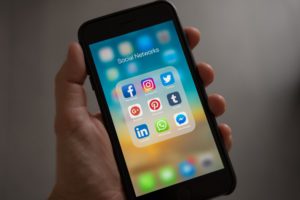What you need to know about Digital Eye Strain

Digital eye strain: the effect screens have on your eyes
For many of us, almost everyday is filled with looking at digital screens, from the moment we wake up until the time we go to bed. Whether it’s for work, keeping in touch with family and friends or checking the news.
As we continue to use devices on a daily basis, we need to be asking ourselves, what effect does this screen-time have on our eyes?
Here to help you get the facts straight, we explain what digital eye strain actually is and share our expert advice to help you alleviate sore, tired eyes and look after your eye health.
The link between screens and eye health
As we become more and more accustomed to ever increasing screen time, our eye health is being affected. While we can’t say for sure whether the use of computers and screens cause permanent eye damage, we do know that there are negative effects from our daily use of screens.
Digital eye strain, also known as computer vision syndrome, is caused by staring at digital screens for long periods of time. It is a medical issue and studies have shown that it affects over 50 percent of computer users.
As a medical condition, it has serious symptoms, such as:
–Blurry vision
–Sore eyes
-Watery eyes
–Headaches
–Dry and irritated eyes
–Difficulty focusing
–Neck and back pain
Why do screens cause such a strain on our eyes?
Vision is a complex process that is very perceptual, yet often mistakenly believed to be purely mechanical. Because human vision is so complex, almost a fifth of the brain is devoted to visual processing cells.
With all of these complex processes at work, it’s no wonder that many people experience problems when using computer screens for long periods without breaks. In fact, a significant percentage of people who experience visual discomfort will be found to have uncorrected vision problems.
The good news is that they can often find relief with glasses or contact lenses that are suitable for their everyday screen use.
What’s all the fuss about blue light?
 Blue light is of course a natural phenomenon – it is present in daylight and helps us to stay awake. But excessive amounts can have an adverse effect and cause eye strain and fatigue.
Blue light is of course a natural phenomenon – it is present in daylight and helps us to stay awake. But excessive amounts can have an adverse effect and cause eye strain and fatigue.
Computers, laptops, televisions, smartphones, tablets and gaming devices all emit blue light and nearly 60% of us are looking at digital screens for 5+ hours per day. This has increased our daily dose of blue light or high energy visible light emissions dramatically.
Studies suggest that continued exposure to blue light over time could lead to damaged retinal cells, the innermost part of our eye which is highly sensitive.
Unlike UV rays, which the eye can partly block from reaching the retina, it is harder for our eyes to block blue light, which means it can have an impact on our retina.
Overexposure to blue light, especially at night, can also disrupt your sleep. This is because your body uses natural blue light to regulate your sleep cycles. Exposing your eyes to too much blue light, especially late at night, can disrupt this natural cycle.
How to prevent digital eye strain
With so many of us being affected by our digitally connected lifestyles, it’s important to always check in with our eye health. While the use of devices is practically a fact of life, there are many tips and tricks that you can use to keep looking after your eyes.
Take breaks
 Because computer users tend to work with the screen a fixed distance away, the unchanging demand on the eye muscles can lead to them becoming fatigued. But like all our muscles, the eye muscles need periods of relaxation, too.
Because computer users tend to work with the screen a fixed distance away, the unchanging demand on the eye muscles can lead to them becoming fatigued. But like all our muscles, the eye muscles need periods of relaxation, too.
Try to remember to take regular breaks from your screen. This could be a walk around the room, or simply focusing on a distant object for a minute or two. By shifting your focus, you’re giving the muscles in your eyes time to rest and recover.
Quick tip: Try the 20-20-20 rule. This means every 20 minutes, stare at something 20 feet away for 20 seconds.
Blink often
This is key! While blinking comes naturally, we often forget to blink when staring at a screen. This causes our eyes to dry out, so try to remember to blink every few seconds.
Did you know? If you work or live in an air-conditioned environment and spend a lot of time looking at screens you are more at risk of developing dry eye.
If your eyes dehydrate and feel gritty or sore you should come in and see us for an eye examination. It is important to identify the specific causes of your dry eye and we can recommend treatments accordingly.
Remember, it’s not a good idea to leave dry eye untreated as the symptoms can worsen and become chronic if left for too long.
Adjust the brightness of your screen
 Staring at a bright screen, especially at night, can cause eye strain and keep you awake longer, affecting the quality of your sleep.
Staring at a bright screen, especially at night, can cause eye strain and keep you awake longer, affecting the quality of your sleep.
Try adjusting the brightness of your screen, or download f.lux, for windows or mac computers, a free software that automatically adjusts the brightness and blue light levels of your screen based on the time of day.
For Apple or Android phones and tablets check your display settings to enable night-time modes that will adjust your screen brightness for evening use.
Check the placement of your computer screen
 Eyes are more comfortable with a downward gaze for near work, so a low screen is better for the eyes and neck than a high screen. Make sure that the top of the screen is at or below eye level when the head is held naturally and that you are sitting comfortably.
Eyes are more comfortable with a downward gaze for near work, so a low screen is better for the eyes and neck than a high screen. Make sure that the top of the screen is at or below eye level when the head is held naturally and that you are sitting comfortably.
Multi-focal or progressive lens wearers need to view the screen through the lower part of their glasses. Make sure that the screen isn’t too high so that you don’t tilt your head back to see. You don’t want to strain your neck by using an unnatural posture.
Eye wear for a digital lifestyle
If you’re experiencing daily eye strain when using your computer, it might be time to try protective eye wear to help alleviate the blue light exposure and protect your eye health in the long term.
If you wear glasses for computer use we can easily add a blue control filter to your eye wear.
-Neutralizes blue light, preventing eye strain and fatigue
-Reduces glare for more comfortable and relaxed vision
-Provides better contrast perception, offering a more natural colour experience
Ask about our Chem Tech ready-made blue blocking lenses for non prescription wearers.
Have regular eye exams
As we always recommend here at Greenlane Penrose Optometrist, don’t forget your regular check-ups. Just like going to the doctor or dentist, you need to have an eye health-check. This is important at all ages and especially as we are using more technology in our daily lives.
Don’t forget that some eye problems are caused by weaknesses in eye focusing or eye coordination and cannot be adequately corrected with lenses. In these cases, a program of Vision Therapy can make all the difference to your comfort and efficiency.
We recommend booking in for an eye exam every 2 years or sooner if you have any worrying symptoms. Eye exams let us check in with your eye health and are opportunities to identify early signs of eye conditions before they become major issues.
Are you experiencing digital eye strain? We can provide helpful advice and assessments of your eye health. Phone us on 5251516 to book an appointment.
Featured Posts
Beat the sun with our prescription sunglasses range
by Jenny Not only can you look stylishly good, but sunglasses serve as eye disease protection.Did you know:UV radiation increases your odds of getting cataracts, or clouding over the lens of one’s eye. This makes the use of sunglasses an important factor for...
Fitovers: fit for summer enjoyment
by Jenny Stylish sun protection with FitoversContinuously maintaining an emphasis on comfort, quality and visual performance, Fitovers eyewear use state-of-the-art frame and lens technologies to provide modern prescription frame wearers with a fit over...
Address
Cnr Great South Road & Rockfield Road, Greenlane 1051
Phone
09 525 1516
Hours
Mon to Fri: 9am – 5pm
Sat to Sun: Closed
Holidays: Closed


